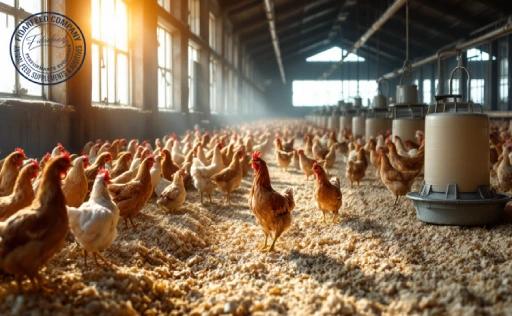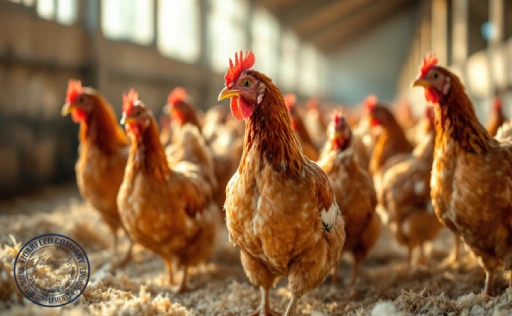
How to Maintain Optimal Temperature and Humidity for Breeder Hens is one of the most important — yet often overlooked — aspects of successful poultry breeding. Whether you’re an experienced breeder or just starting out, you already know that keeping hens healthy and productive is your top priority. But even the best feed and care won’t deliver results if the birds are living in an uncomfortable climate.
Temperature and humidity directly affect breeder hens’ health, egg production, and fertility. In this article, you’ll discover why maintaining proper conditions matters so much, what signs to look for, and how to create an environment where your flock can thrive. We’ll also explore practical techniques and affordable tools you can use starting today. Let’s dive in and give your hens the comfort they deserve — and your operation the results you need.
Why Maintaining Optimal Temperature and Humidity for Breeder Hens Matters
Breeder hens are sensitive creatures. Unlike laying hens kept only for eggs, breeders must maintain both egg production and fertility — a demanding task for their bodies. When the environment is too hot, too cold, or too damp, hens become stressed. Stress, as countless studies confirm, directly harms their immune system, appetite, and reproductive performance.
Learn more about: Product
High temperatures can cause hens to eat less and lay fewer eggs, while low temperatures may lead to poor fertility and increased illness. Similarly, high humidity fosters bacteria and mold growth in the house, while very low humidity can dry out the birds’ mucous membranes, making them more susceptible to disease.
When you provide the right temperature and humidity, hens remain calm, eat properly, lay consistently, and stay fertile longer — all crucial for a profitable breeding program.
How to Maintain Optimal Temperature and Humidity for Breeder Hens: The Basics Every Breeder Should Know
So what are the “magic numbers” every breeder should aim for? While exact values can vary slightly by breed and age, here are general guidelines most experts recommend:
-
Temperature: Breeder hens typically perform best at around 18–22°C (64–72°F). Temperatures above 27°C (80°F) can cause heat stress, while temperatures below 15°C (59°F) may reduce productivity.
Learn more about: How to Breed Broilers at Home: A Step-by-Step Beginner’s Guide
-
Humidity: Relative humidity should ideally stay between 50–70%. Too much moisture in the air promotes respiratory diseases and dirty eggs, while too little dries out bedding and the birds’ airways.
These ranges strike a balance that supports both comfort and hygiene. It’s also crucial to adjust for age — younger birds need slightly warmer conditions, while mature hens tolerate cooler environments better.
Common Problems Caused by Poor Temperature and Humidity Control in Breeder Houses
Ignoring climate control in your breeder house can lead to serious problems, some of which may take time to appear but can devastate your flock and profits:
-
Heat stress: Birds pant excessively, reduce feed intake, lose weight, and lay fewer eggs. Fertility rates also drop.
-
Cold stress: Hens burn energy to keep warm, leading to poor egg production and higher mortality, especially in chicks.
-
High humidity: Wet litter, bacterial growth, coccidiosis outbreaks, and dirty eggs that lower hatchability.
-
Low humidity: Dry dust irritates hens’ eyes and lungs, increasing respiratory issues. Eggs may also lose moisture too quickly, affecting embryo development.
Learn more about: Complete Guide to the Management of Breeding Stock and Broilers
These challenges not only lower production but also increase veterinary costs and labor demands.
Signs Your Breeder Hens Are Too Hot, Too Cold, or in Poor Humidity
Since hens can’t tell you they’re uncomfortable, you need to watch closely for signs that something’s wrong:
-
Too hot: Birds spread their wings, pant heavily, crowd near water, and eat less.
-
Too cold: Hens huddle together, fluff up their feathers, become lethargic, and increase feed consumption.
-
High humidity: You may notice damp litter, a musty smell, dirty feathers, and more respiratory illness.
-
Low humidity: Dry, flaky litter; dusty air; coughing or sneezing birds; poor eggshell quality.
Learn more about: The Ultimate Poultry Breeder Management Guide: Boost Your Flock’s Productivity
Checking both the birds’ behavior and the condition of the house gives you a clear picture of what needs adjusting.
Best Practices for Maintaining the Right Temperature and Humidity for Breeder Hens
Fortunately, creating and maintaining optimal conditions isn’t complicated if you follow some proven practices:
-
Ventilation is key: Ensure fresh air flows without creating drafts. Proper ventilation removes excess moisture and heat while keeping air clean.
-
Insulate the house: Insulation helps keep temperatures stable, reducing energy costs and protecting the flock from sudden weather changes.
-
Manage litter properly: Dry, clean bedding absorbs moisture and keeps ammonia levels down. Replace or stir it regularly.
Learn more about: Probiotics for Poultry Farming: Boost Gut Health & Performance
-
Monitor and adjust daily: Use thermometers and hygrometers to track conditions. Don’t rely on guesswork — even small changes can matter.
-
Use heaters or fans when needed: Supplemental heating in winter and fans in summer help keep birds comfortable.
-
Schedule chores wisely: Handle birds and clean houses during cooler parts of the day to reduce heat stress.
Learn more about: Which Broiler Breed is the Best? A Comprehensive Guide for Farmers
These steps also contribute to better air quality, which improves both flock health and worker comfort.
Tools and Technology to Help You Manage Temperature and Humidity Effectively
Modern tools make it much easier to maintain the right climate — and many of them are affordable even for small operations. Here are a few worth considering:
-
Digital thermometers and hygrometers: Accurate and easy-to-read devices to monitor the house environment.
-
Automatic controllers: Systems that adjust fans, heaters, and humidifiers based on real-time conditions.
-
Misting systems: Help cool birds during hot weather while maintaining humidity.
-
Data loggers: Record temperature and humidity over time, helping you identify patterns and fix problems early.
Learn more about: What is the Best Way to Manage Poultry Litter on My Farm? A Comprehensive Guide
Even with basic equipment, consistency and vigilance are what truly make the difference.
Final Thoughts: Keeping Breeder Hens Comfortable for Maximum Productivity
Providing the right temperature and humidity is one of the most effective ways to keep breeder hens healthy, fertile, and productive. It’s not just about numbers on a thermometer — it’s about respecting the needs of your flock and creating an environment where they can thrive.
Breeders who pay attention to climate control see better egg production, higher hatchability, healthier birds, and greater overall profitability. Whether you’re raising a small flock or managing a large facility, these principles remain the same — and the rewards are well worth the effort.
Have you faced challenges keeping your breeder hens comfortable? Or perhaps you’ve discovered techniques that worked wonders for your flock? Share your thoughts, ask questions, and join the conversation in the comments below. Together, we can help every breeder achieve healthier flocks and better results.
Thank you for reading — here’s to your success in creating the perfect environment for your breeder hens!









